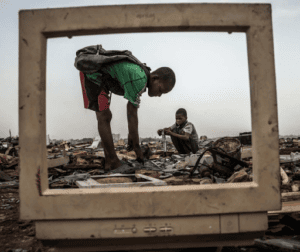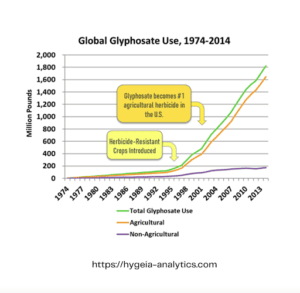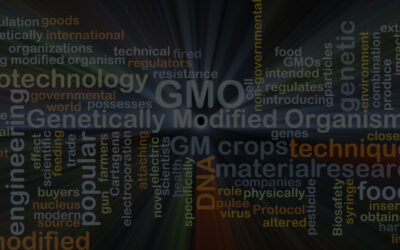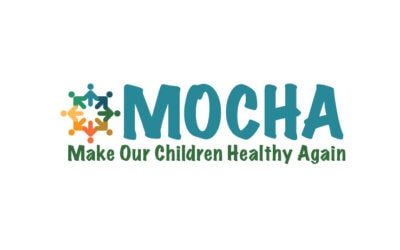It’s Time: A Children’s Environmental Health Bill of Rights

Globally, the health of our children is under assault. Chronic disease amongst our most vulnerable is rampant. The main drivers of this present health disaster are environmental toxicants. Californian state lawmakers proclaimed that October 2021 is Children’s Environmental Health Month, raising awareness about the need for clean air, water and food to protect children. Let’s make it a world-wide law, starting with an Environmental Health Bill of Rights; the goal being to support every child.
The following editorial is a summary statement of the main factors affecting the well-being of our children, and not meant to provide an all-inclusive list. Whilst it is known that children are inundated with over 100,000 chemicals according to the European Environment Agency (EEA), as well as other environmental insults, there are clearly priorities that must be principally showcased and addressed. Six major areas that require urgent attention are addressed below.
The Children’s Environmental Health Bill of Rights
- Children require organically grown food free from chemical inputs
Genetically modified organisms and their associated pesticides entered our children’s diets in 1996, and they have been consuming them for over 25 years. Despite harm first identified by Dr. Arpad Pusztai, upon revealing his findings from the first GMO study, agribusiness was allowed to roll out GMOs into our children’s mouths ever since. The findings of his work were rapidly followed by a slanderous personal attack and his immediate removal from the Rowett Institute where he had dedicated 37 years of superlative research.
In 2019, the FDA released a guidance document for industry regarding ‘voluntary labeling’, and how to identify products from genetically engineered plants. The FDA document goes on to define what comprises “genetic engineering”:
In this guidance, we use the terms “genetic engineering” and “bioengineering” to describe the use of modern biotechnology. Modern biotechnology means the application of in vitro nucleic acid techniques, including recombinant deoxyribonucleic acid (DNA) and direct injection of nucleic acid into cells or organelles, or fusion of cells beyond the taxonomic family, that overcome natural physiological reproductive or recombinant barriers and that are not techniques used in traditional breeding and selection of plants. The term “modern biotechnology” may alternatively be described as “recombinant DNA (rDNA) technology”, “genetic engineering” , or “bioengineering.” These terms are often used interchangeably by industry, federal agencies, international bodies, and other interested stakeholders and are used in this guidance to refer to foods derived from new plant varieties developed using modern biotechnology. The term “genetic modification” is also sometimes used to refer to the use of modern biotechnology, although FDA’s longstanding position, as discussed later in this guidance, is that such use of the term is less accurate because the term encompasses the broad spectrum of genetic alterations that can be made in plants.
The end result of this position held by government regulatory agencies like the FDA, requires parents to have a PhD in genetics to be able to shop the aisles of their local market while trying to avoid GMOs. Without labeling in the US, parents are unable to identify which foods are industrialized “food-like” products and which are produced without engineering, fueling confusion as to what was once the simple act of feeding a child.
A key feature in scientific research is the replication of findings of a study. The impetus to further study GMOs which could identify and reproduce the harm first demonstrated by Dr. Pusztai was not willingly taken up by researchers, secondary to potential conflicts of interest often at odds with the subsidies/grants institutions received from industry. However, Dr. Michael Antoniou, the Director of Gene Therapy and Gene Expression at King’s College in the UK, employing cutting edge technology, identified metabolomic changes resulting in lab animals fed GMOs as well as other metabolite changes disproving ideas of equivalency between GMO and non-GMO products. Dr. Gilles-Eric Seralini also published findings of significant toxicity from GMOs and glyphosate-based herbicides in a rat toxicology study. Thus, other scientists have since substantiated the findings of health harms originally shown by Dr. Pusztai. Despite clear cut demonstrable health hazards from this technology, new GMOs were released, more sophisticated technologies regarding gene editing/CRISPR were made available and genetic engineering regulation by the government essentially disappeared. This is a formula for a children’s health tsunami.
While the GMO effects are significant, remember that they are consumed with their concomitant pesticides. Since the time of Rachel Carson and her landmark book,
A Silent Spring (1962), the negative effects of pesticides have been long known regarding children’s health. Again in 1993, there were reports calling out the lack of regulatory safeguards to protect children from pesticides. These warnings have gone unheeded as global glyphosate usage continues to skyrocket. While there are many harmful effects of glyphosate, the main toxic effects can be seen in their ability to disrupt intestinal permeability, alter the microbiome (a key player in immune, neurologic and hormonal health), identified as a causative agent of autism (which has now reached pandemic levels), as well as having been shown to have a direct link to asthma. This is a brief list of the many ill effects caused by glyphosate-based herbicides on children. Additionally, industry lists many ‘inert’ ingredients in their formulations which are neither inert or reported due to proprietary discretion.

The struggle is against pesticides is real, and it’s personal, affecting families universally: (From GMWatch Daily Digest 27 Oct. 21)
A mother in Argentina describes her family’s severe health problems linked to the large quantities of pesticides (notably glyphosate) sprayed on GM soy. Toxicology tests showed that her son’s body contains a level of pesticides 120 times higher than he is capable of tolerating. Her daughter has a little less, 100 times more than she could tolerate. They both have at least twice the levels found in adults. The entire family has genetic damage.
Read the full story of Sabrina Ortiz, mother of two children severely harmed by pesticides here.
The situation is in constant flux and it is only very recently that Bayer (owner of the glyphosate-based herbicide, Roundup) decided to withdraw this product from garden usage in the US as litigation against Bayer spirals into the hundreds of thousands of victims. There are presently over 1,000 glyphosate-based formulations available for purchase, so the outcome of this action on the herbicide market remains to be seen.
- Children require clean water, free from environmental pollutants
The Environmental Working Group published a landmark study in 2017 regarding tap water contaminants. Over a five year period, 50,000 water companies were surveyed in the US from 2010 to 2015, comparing their findings to science-based health guidelines. More than 250 contaminants were found, and the more chemicals tested, the more chemicals that were identified. A brief summary of their findings showed:
 93 chemicals were linked to cancer
93 chemicals were linked to cancer
- 78 chemicals were linked to brain and nervous system problems
- 63 contaminants were identified that can harm the development of the fetus or young child
- 38 contaminant were linked to human fertility problems
- Over 45 contaminants were linked to hormone disruption
It should be clear that these contaminants are more harmful during critical windows in childrens’ development. Higher amounts of more than 90 contaminants were identified than scientists consider safe for children. Water contamination is especially concerning for bottle-fed babies whose formula is made from tap water. (Consider the fact that 85% of a formula-fed baby’s diet is made from tap water until solid foods are introduced.)
The call for clean water free from chemical contamination could lead to profound improvements in health. Many substances polluting drinking water are not biodegradable, such as the forever chemicals (per and polyfluorinated substances, PFAS), made infamous in a 2019 film, Dark Waters. They have been introduced in consumer products since the 1950s, contaminating water, food, and air. PFAS have broad systemic toxicity including effects on children’s growth and development, future reproduction, endocrine function, liver function and demonstrate carcinogenicity. The usage of PFAS has extended from personal care products, to non-stick cookware, fast food packaging and pesticides. Children’s natural exploratory nature is hand-to-mouth behavior, thus increasing their exposure from oral contact from these poisonous substances. Their documented contamination particularly in water, has been studied in a recent survey in Middle Eastern and Asian countries which reported on many alarming findings regarding PFAS:
- PFAS are poorly regulated in all countries examined
- PFAS contaminates adults and infants
- Water pollution with PFAS substances is widespread
- Marine and terrestrial organisms are contaminated with PFAS
- Firefighting foams and extinguishers containing PFAS are in use
- Consumer products are contaminated with PFAS
- PFAS substances contaminate dust and particulate air pollution
- US military bases in Japan cause PFAS pollution
- Japan is an important PFAS producer
- Children require clean air
The World Health Organization (WHO) in 2016, reported that air pollution contributed to respiratory tract infections leading to the death of 543,000 children under the age of 5 years old. The major contributors to the pollution crisis are fossil fuel combustion, waste incineration, dust storms, wildfires, industrial processes and cooking/heating homes. Of note, 93% of children under 15 years old are exposed to ambient air pollution with fine particulate matter (PM) levels higher than the WHO air quality guidelines. An equally staggering statistic shows that low and middle income countries experience death rates that are 40 times higher than in more affluent countries.
Why does air pollution have a greater impact on children? Children as compared to adults spend more time outdoors, playing and breathing faster which increases their relative exposure to air pollution. Children are not mini-adults exhibiting unique physiology. Relative to their size, children breathe more than adults. Coupling their more rapid respiration with decreased biological defenses (nasal passages and detoxification pathways), they are more at risk from air pollution. The fetal risks and early life developmental exposures have the greatest potential to influence future health developments. Higher levels of PM greater than 2.5 increased children’s visits to emergency departments with asthma and respiratory-related issues, disproportionately affecting those living in proximity to traffic, from lower socioeconomic areas, and in urban areas.
There have been attempts by different states in the US to address the issue of children’s environmental health protection regarding air quality. The Children’s Environmental Health Protection Act was passed by the California Legislature in 1999, requiring monitoring and assessment of whether control measures in place were adequate to protect children. This act was designed to identify toxic air contaminants and develop new regulations to reduce exposure if contaminants were identified. Although this type of programming should be applauded, the questions to be addressed are whether it is indeed working, whether this action is substantive and lastly, does a wider net need to be casted to address a larger population of children. In this author’s opinion, this is a good start, but not enough.
- Children require reduced exposure to electromagnetic frequencies (EMF) and no exposure to 5G
On March 25, 2019, it was reported that 4 students and 3 teachers in Ripon California, were diagnosed with cancer within a 3-year period after a 5G tower was placed at their school. Scientists argue that research on brain tumors and radio frequency radiation should be a Class 1 known carcinogen.
The IARC cancer classification includes all sources of RF radiation. The exposure from mobile phone base stations, Wi-Fi access points, smart phones, laptops and tablets can be long-term, sometimes around the clock, at home, at work place, at school, and in the environment. For children this risk may be accentuated because of a cumulative effect during a long lifetime use (Hedendahl et al., 2015).
 Additionally, there are many concerning reports of cognitive dysfunction in adolescents including delayed fine and gross motor skills, memory issues and focus/attention alterations when tower settings were placed adjacent to school buildings. It should be noted that the concept of neurological harm from electromagnetic pollution can be traced back 50 years to reports from the former Soviet Union describing a “microwave syndrome” in individuals working with radio and radar equipment including neurologic issues, fatigue, insomnia, and other systemic complaints. Similar symptoms were reported in Swedes and Finns. Most parents are unaware of this type of harm from EMF exposure which is hard to quantify, detect, diagnose and treat. Abandonment of books in favor of wireless devices has been exponentially increased during school closures and lockdowns during the 2020-21 CoV-2 pandemic.
Additionally, there are many concerning reports of cognitive dysfunction in adolescents including delayed fine and gross motor skills, memory issues and focus/attention alterations when tower settings were placed adjacent to school buildings. It should be noted that the concept of neurological harm from electromagnetic pollution can be traced back 50 years to reports from the former Soviet Union describing a “microwave syndrome” in individuals working with radio and radar equipment including neurologic issues, fatigue, insomnia, and other systemic complaints. Similar symptoms were reported in Swedes and Finns. Most parents are unaware of this type of harm from EMF exposure which is hard to quantify, detect, diagnose and treat. Abandonment of books in favor of wireless devices has been exponentially increased during school closures and lockdowns during the 2020-21 CoV-2 pandemic.
Whether the health harms from EMF/RFR (radiofrequency radiation) are known by physicians is unclear. What is known are the physiologic effects caused by exposure and the type of damage caused and needs to be broadcasted to clinicians caring for children. Some of the effects reported include the following:
- Cellular stress with the creation of heat shock proteins
- Damage of cell membranes, creating leaky membrane and loss of electrical differences
- Damage to mitochondria with subsequent alterations of chemical conduction reactions on their cellular membranes
- Creation of oxidative stress (free radicals) – difficult to maintain enough antioxidants to keep pace with the stress in children
- Genotoxicity from free radical damage to DNA
- Depletion of glutathione, the body’s major antioxidant
The frustration mounting from EMF/RFR exposure stems from the fact that this is an unnecessary exposure and there are remediation steps that can be taken towards prevention. Homes and schools can be hardwired which are safer, faster, and less vulnerable to privacy issues. Wifi access points and devices can be turned off when not in use. Content for teaching can be downloaded to devices prior to school lessons when attendance in person is not possible. Cell phones and other wearables can be prohibited in classrooms which is already occurring in some countries. Lastly, it would behoove industry to provide devices and software with hardwired features.

Students in France under 15 years old are banned from using their cell phones at school.
Chancellor Belboni removes a wifi router in at St. Augustine School, Italy

In addition to children, pregnant women also share an increased health risk from exposure to wireless radiation. There are now programs targeting pregnant women and safeguarding unborn children.
- Children should not be subjugated to experimental medical therapies/drugs
Children cannot give informed consent, so bypassing systems giving children experimental treatments without parental acknowledgement is illegal. It is unethical to give children a type of therapy or treatment for the benefit of adults when the child’s risk outweighs the benefit that they might receive from the therapy. This idea of “cocooning”, meaning using the child as a shield to protect adults, is off the table and this option should not be considered due to its immorality and glaring lack of consideration of the child placed at an unnecessary risk.
There is no doubt that the introduction of experimental therapies is not in children’s best interest, however, for those medical practitioners and scientists that have raised concerns regarding the administration of scientifically unvalidated treatments to children despite evidence showing harm, have had their voices silenced and their careers threatened. It appears that there is a threshold of what is acceptable and what is unacceptable in terms of the type of concerns that can be raised by those that are advocates for children’s health. There is no more poignant time than the present time which we are facing during the CoV-2 pandemic where this issue has been brought to light.
The recent introduction of mRNA and DNA vector immunomodulatory therapies are a prime example of novel experimental treatments which have been shown that their administration to children has caused more harm than demonstrable benefit. Historically, treatments (such as the rotavirus vaccine in 1998) have been released and quickly recalled after negative outcomes began being noted and reported. Upon release of the mRNA and DNA gene therapies, designed to produce viral spike protein and stimulate the child’s immune system to mount an immune response against their own native production of the protein, there have been serious sequelae including neurologic, cardiac, and hematologic side effects. Historically speaking, there were times when children were given cocaine for toothaches, diamorphine (heroin introduced by Bayer) for children with coughs and colds, aspirin for children with viral illnesses or teething gels (benzocaine) for babies. These therapies are no longer recommended, however, they were once used with impunity. The best philosophical guidelines for children include following the precautionary principle and abiding by the first rule of medicine: Primum non nocere: First do no harm.
- Children should not be exposed to environmental toxicants, such as e-waste
In 2019 as per the WHO, 53.6 million tons of e-waste (TVs, computers, phones, etc.), were created, and this number is continuing to increase. Children are involved in the recycling process, exposed to high levels of lead mercury, cadmium, PCBs, and dioxins.
The methods by which this process occurs may be by open burning of materials, heating and acid leaching using toxic chemicals for extraction of precious metals (cyanide salt, nitric acid or mercury). The health impacts on children are profound including impaired neurodevelopment, poor birth outcomes, respiratory illness, hormone dysfunction, DNA damage, immune suppression/autoimmunity and the risks of future chronic diseases (such as cardiovascular disease and cancer). There have been over 1,000 harmful substances identified. The worst offenders include heavy metals, persistent organic pollutants (POPs) and fine particulate matter (PM2.5).
As mentioned previously, children’s unique physiology places them at a greater risk for harm from these chemicals:
- Ingestion (contaminated water, breastmilk, soil and dust, including from dust- contaminated toys or surfaces
- Inhalation of particles, including those from open burning, increases their exposure
- Children have larger dermal-to-weight surfaces as compared to adults and skin contact with toxicants is another risk factor for children
- Transplacental exposure in utero is a toxic burden to both pregnant mothers and the unborn
It is possible to create safe waste-picking facilities, such as one located in Sao Paulo, Brazil (Coopermiti, created 2010). Workers follow occupational safety and health regulations to mitigate health risks. There are international standards that specify requirements, but whether children are considered in these regulations is unclear. Despite progress in waste collection and extraction, difficulties persist particularly in low income communities.
The challenges are clear, but how these challenges are met are not as straightforward. As the adoption of a global shift in our thinking on how children are best supported, a concomitant shift in the medical model needs to occur simultaneously. There is the need for an additional call for ecomedicine; an integrative paradigm for real healing based on holistic health principles and prevention.
In sum, embracing planetary health for our most vulnerable, our children, can only occur when laws are enacted and individuals are held accountable. It’s time.


 93 chemicals were linked to cancer
93 chemicals were linked to cancer 

